The Turbinia is the first steam turbine-powered steamship. It was an experimental, private venture by Charles Algernon Parsons, ten years after he invented the concept, in 1884. The concept was proposed by the admiralty but the first trial was unsuccesful. As an engineer certain of its applications, he devised a risky plot: Rushing out unannounced and unauthorized at the Spithead 1897 Review. Being easily the fastest ship in the world at that time, the private yacht Turbinia immediately succeeded in managing attention of all present, including the admiralty. It led to the construction of the first practical turbine destroyers for the Royal Navy, then destroyers, cruisers, and eventually under the impulsion of Sir ‘jackie” fisher, HMS dreadnought less than ten years afterwards, before conquering the world by storm and put an end to the long reign of Vertical Triple Expansion Engines. For its historical, engineering, technical significance, Turbinia was not scrapped after being retired in 1927. She was fully restored and now is currently displayed at the Discovery Museum in Newcastle upon Tyne, but her original powerplant is now at the Science Museum in London.
Development
Charles Algernoon Parsons
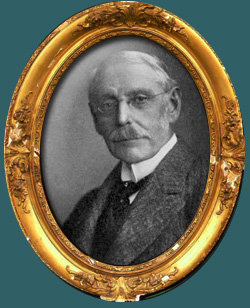 Father of MS Turbinia and the end of torpedo boats. The story indeed could not be started without the contribution of one engineer in particular: Charles Algernon Parsons.
Father of MS Turbinia and the end of torpedo boats. The story indeed could not be started without the contribution of one engineer in particular: Charles Algernon Parsons.
To close this topic, let’s cite a famous third pioneer, vital for the RN small ship’s inventory: Parsons was born into an Anglo-Irish family in London, his father being the famous astronomer William Parsons, 3rd Earl of Rosse. Educated at home in Ireland by private tutors, he attended Trinity College, Dublin and at St. John’s College in Cambridge, graduated 1877 before starting work at Newcastle’s W.G. Armstrong as an apprentice, then Kitsons, Leeds, on rocket-powered torpedoes. In 1884 he was hired by Clarke, Chapman and Co., ship-engine manufacturers near Newcastle. From the electrical-equipment dept. he developed a turbine engine that same year to drive the electrical generator he designed.
This was revolution, more efficient than the one invented by Gustaf de Laval (1845–1913) working on an impulse design and did not worked due to the materials of the time. Logically, in 1889 he founded C. A. Parsons and Company in Newcastle to produce his turbines, that he scaled up and improved constantly, and the Newcastle and District Electric Lighting Company (DisCO) later opening in 1890 the world’s first power-station using turbo generators. In 1894 with patent rights from Clarke Chapman he rapidly improved the poor efficience of the first model (1.6%, 7.5 KW) to a megawatt turbine in 1899, and seeing fruitful prospects with the Royal Navy he also founded the Parsons Marine Steam Turbine Company, also in Newcastle.
Enters Turbinia
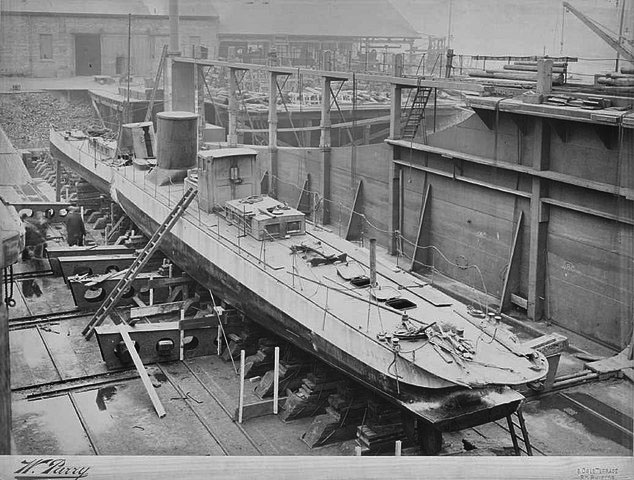
The Turbinia in repair after her collision
In June 1897 he had a his personal yacht experimenting a turbine, named “Turbinia”. He made a publicity stunt by turning up unannounced at the Queen Victoria Diamond Jubilee, and made a splash by being spotted by all present at the Navy Review in Spithead, this 26 June 1897. He attracted the attention of the Prince of Wales, foreign dignitaries, and Lords of the Admiralty, moving at 34 knots (63 km/h; 39 mph) while the fastest ships in the RN at the time reached 27 knot (50 km/h; 31 mph). But he achieved this not only based on the efficience of his turbine. The latter was narrow, and he created a slender hull around like a glove, making the Turbinia an unbeatable “greyhound”.
Needess to say, the Admiralty was impressed, and despite its policy disregarding light ships at the time, just to avoid such design falling into foreign hands like Russia, France or Germany, two orders were rapidly made to Parsons Yard the next years: These were scaled-up to carry two turbines each: The destroyers HMS Viper and Cobra. He also received an order from a civilian yard to have the first turbine-powered passenger ship, the TS King Edward, in 1901. What followed were the turbine-powered transatlantic liners RMS Victorian and Virginian (1905) and of course HMS Dreadnought in 1906.

The Turbinia at sea, at full speed. The world’s first turbine-powered vessel. By that stage, the torpedo boat era was over in Britain.
Design of the class
About the steam turbine
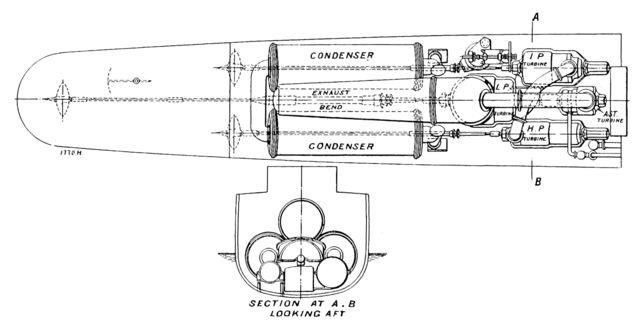
Charles Algernon Parsons invented the modern steam turbine in 1884. The steam turbine is basically a device converting the energy contained in steam into mechanical work. It’s a crucial component in many power generation systems, particularly in thermal power plants. The process typically begins in a boiler where water is heated to produce steam. This can be achieved through various means such as burning fossil fuels like coal, oil, or natural gas, or through nuclear reactions in nuclear power plants. Expansion into high-pressure steam is generated in the boiler and then directed into the steam turbine. As the steam flows through the turbine, it undergoes expansion. The steam’s pressure and temperature drop as it passes through the turbine blades.
The expanding steam causes the turbine blades to rotate.
The rotating shaft of the turbine is connected to a generator, and as the shaft turns, it drives the generator to produce electricity.
After passing through the turbine, the low-pressure steam is directed to a condenser where it is condensed back into water. This process typically involves cooling the steam using water from a cooling tower or a body of water, returning it to its liquid state. The condensed water is then pumped back into the boiler to be reheated and reused in the steam generation cycle.
Over time, the flow of steam was instrumented in ways to obtained every bit of pressure being converted to some power, and combinations of low and high pressure inside the turbines to run at economical speeds.
Indeed the common critic at the time for those in all navies which were sceptical and wanted to keep triple expansion models (it was a true choice and the latter survived for many decades, and in fact is still use today) is that the latter is sober and somewhat less noisy. The turbine however could provide better speeds, while causing far less vibrations. It took less space as well, as the VTE was traditionally tall. But the latter was far more robust. The next revolution would be the diesel, but the tubine would evolved anyway.
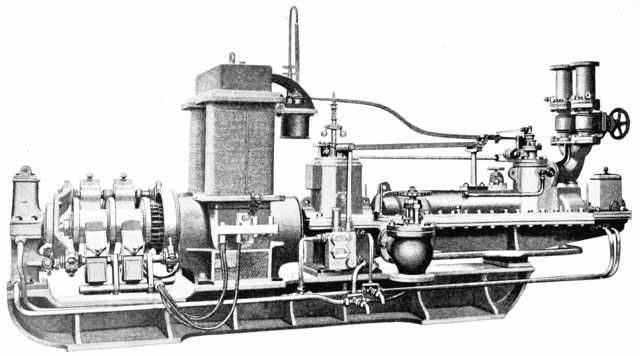
The Parson’s turbine of 1884, the granddady of them all was at the time connected to a dynamo generating just 7.5 kilowatts (10.1 hp) of electricity. This was enough to power a house or small plant, but not a ship. Still, his invention made cheap and democratized electricity and his reaction type device, patented, was licensed by George Westinghouse. The greatest merit of Parson’s model was its ease to be scaled up. Not only huge versions were adopted in most major world power stations, but also larger ships up tp 50,000 kilowatts (67,000 hp) per turbine. The 1960s Kitty Hawk supercarriers for example had four of them, totalling 280,000 shp (210 MW). Today the output generated by land purposes alone exceeds 30 million horse-power. Nothing was as successful before nuclear power, and perhaps nuclear fusion in the next decades.
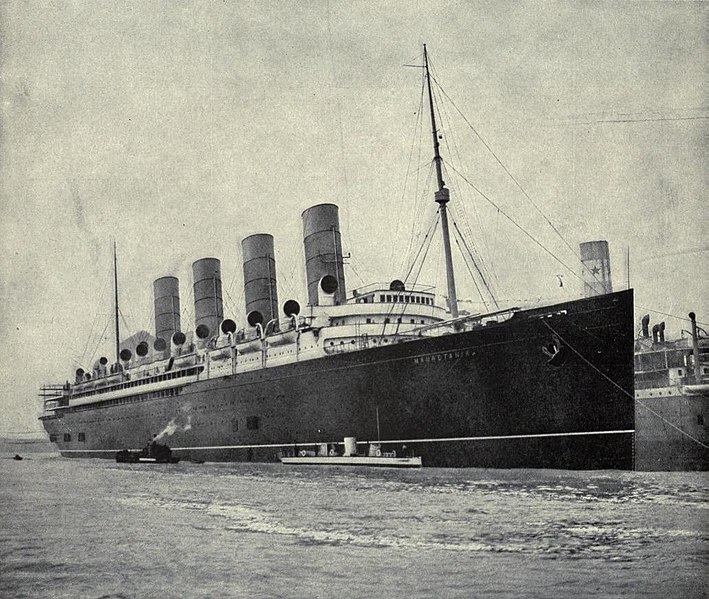
In 1911, the transatlantic liner RMS Mauretania of the Cunard Line was the first ship of that scale to adopt Parson’s turbines. She took the blue ribband and kept it for years. Still, variations of turbines were developed.
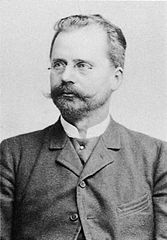 The de Laval turbine (Gustaf de Laval) accelerated it to full speed before running it against a turbine blade. His impulse turbine proved simpler and less expensive as well as pressure-proof, butless efficient. The Swedish engineer (1845-1913) is best remembered for hos steam turbines and dairy technology. His turbine design
The de Laval turbine (Gustaf de Laval) accelerated it to full speed before running it against a turbine blade. His impulse turbine proved simpler and less expensive as well as pressure-proof, butless efficient. The Swedish engineer (1845-1913) is best remembered for hos steam turbines and dairy technology. His turbine design
design utilized the expansion of steam to generate rotary motion, a concept that became fundamental in the development of modern steam turbines. De Laval’s turbines were widely used in various industrial applications, including power generation and marine propulsion. He also was a pioneer of the centrifugal pump.
French engineer Auguste Rateau developed a pressure compounded impulse turbine using part of the Laval principle in 1896 and obtained a US patent in 1903 while the French Navy tested it on a French torpedo boat in 1904. His company is now at the root of Alstom group today. Another turbine pioeer was Slovak physicist and engineer Aurel Stodola, professor at the Swiss Polytechnical Institute in Zurich. He devised a variation as a Heat Engine in 1903 and made another patent in 1922, seems as one of the ancestor of the reactors.
The Brown-Curtis turbine was an impulse type patented by US International Curtis Marine Turbine Co. in the 1900s with John Brown & Co. finding applications both on merchant, warships and liners.
Design of the Turbinia
Hull and general design
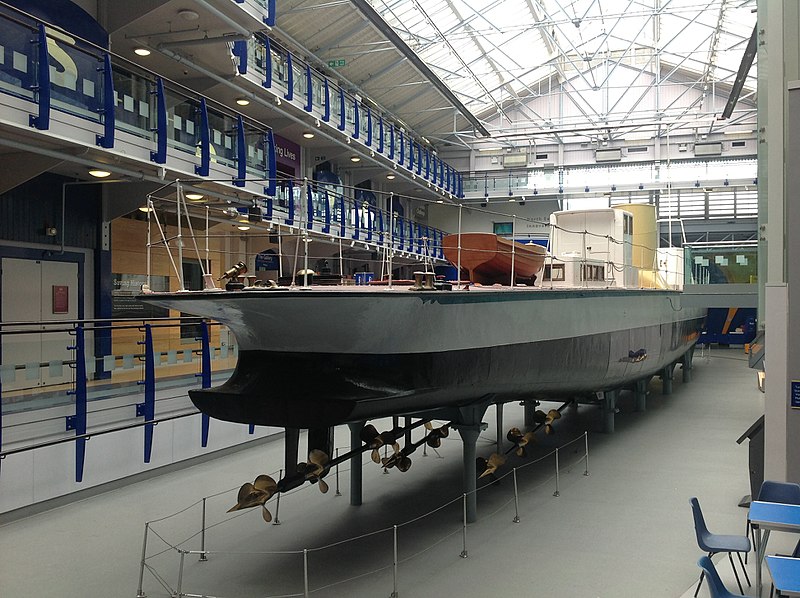
Turbinia at the Dicovery Museum of London, Sept. 2022.
Parson on his side set up the Parsons Marine Steam Turbine Company in 1897 but designed in 1894 the Turbinia as a lightly built demonstrator by Brown and Hood of Wallsend on Tyne, North East, launched on 2 August 1894. Initial trials with one propeller in front of one navy official were disappointing. His report went to the admiralty. Undeterred, Parsons managed to see the issue of cavitation and designed the first cavitation tunnel and eventualy made three axial-flow turbines, connected to three shafts, driving three propellers in a row. This very unusual arrangement of nine propellers was successful hwever this time. Privately, he demonstrated the concept wuth guests on board. Top speed registered this day was in esxcess of 34 knots (63 km/h; 39 mph) and his passengers, impressed, had it nicknamed the “North Sea greyhound”.
His design was one of a nimble, long and narrow vessel, with a straight stem, and curiously shaped stern, combining a rounded upper deck, arching below in a transom end. The deck was flush, with wooden planking and interiors in tropical wood, varnish finish and polished brass fittings. There were two windowed buried cabins fore and aft with accesses, and the only protruduing features were the “conning tower” forward, dotted with portholes and containing the main drive wheel and comunication tubes to the machinery. Behind, about amidship was the single oval funne, raked. The vessel had no mast but a pole that can show a pennant bearing the name of the vessel. The underwater hull was painted dark grey, the hull was white. Later the name “turbinia” was added to the prow after she had been rebuilt, post-accident.
Powerplant
Parson’s 1911 variant of his turbine.
The turbine designed was refined as a three-stage, axial-flow, direct-acting steam turbine. At the final development when she was demonstrated in 1897 at Spithead, she had two 12 ft 6 in (3.81 m) outer shafts, one inner shaft. Each sported like a skewer, three propellers of 18-inch-diameter (460 mm) with 24-inch-pitch (610 mm).
The turbine produced 200 psi (1.4 MPa) in its initial flow whe leaving the unique water-tube boiler, and 170 psi (1.2 MPa) inside the turbine for a total output of 2,100 ihp (1,600 kW)
This made for a 34.5 knots (63.9 km/h; 39.7 mph) knots max speed registered.
The turbines designed for the Turbinia were directly driven. The concept of geared turbines was to wait until 1910. Before this was invented, efficiency of even the axial steam turbines was low, below 12%, perhaps less than 10% for Turbinia.
But nevertheless, this arrangement gave Britain the world’s fastest ship, although the Guiness prize was only invented in 1955, his vessel was trumpeted at home and abroad by newspapers and had many technical reviews.
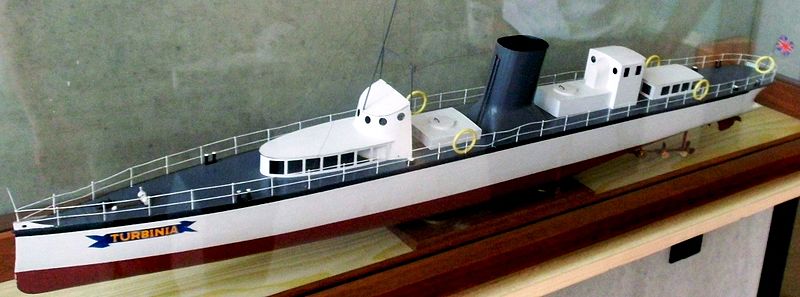
Not least the interest of the Admiralty again, after his “mad mile” at Spithead. At the time, the RN struggled to gave 30+ knots destroyers. The 26 knotters 27 and 30 knotters were to be succeeded by 33-knotters still running on VTE engines, at the peak of their development at the time. yards were adamant that apart having better boilers it was almost impossible to deliver more power, and more acceleration. The turbine broke all barriers and triggered a new serie of destroyers (see below).
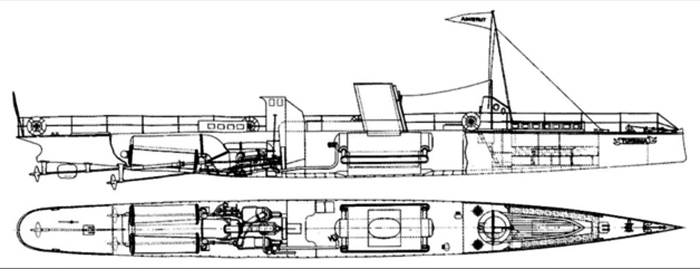
⚙ specifications |
|
| Displacement | 44.5 long tons (45.2 t) |
| Dimensions | 104ft 9in x 9ft x 3ft (31.93 x 2.7 x 0.91 m) |
| Propulsion | 3-shafts/stage AF DA Parsons steam turbine 170/200 psi, water-tube boiler 2,100 ihp (1,600 kW) |
| Speed | 34.5 knots (63.9 km/h; 39.7 mph) |
| Range | c200 nm |
| Armament | None |
| Crew | 12 |
Life of HM Turbinia
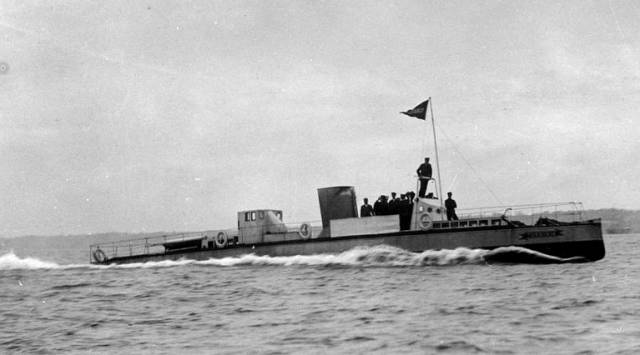
Early trials in 1897
The first trials of turbinia when completed in 1895 with a single propeller were a disappointment to say the least as she barely managed 25 knots. Later most marine issues with the propulsion were solved and in 1896 he made a new sea trials with passenger onboard, and his new triple shaft.triple propellers arrangement. This worked wonders. He registered as he intended 34 knots, knowing this has never been achieved by anyone yet. However as he contacted the admiralty, the latter did not even bother sending an observer. Undeterred, Parson devise a somewhat reckless plan to showcase his yacht.
Parsons’ ship would turn up unannounced at the Navy Review, for the Diamond Jubilee of Queen Victoria at Spithead. This was planned for the 26 June 1897. He knew that was possibly the best spot for a show. It was in front of the Prince of Wales (for support) and foreign dignitaries (for exports) and Lords of the Admiralty (as primary potential customers). This was quite an audacious publicity stunt. At the time, Parsons was aged 43 and that was perhaps his greatest gamble of his life. Coming unnanounced indeed and raced into the lines of ships was risky as there could have been an attempt against the Royal Family, for example with an explosive speed boat. In addition to to all the warships present, not only the whole of the Royal Navy that can be detached from its distant stations across the globe, but also dozens of foreign ones, there were patrolling vessels, all armed and ready. There has been many indeed many anarchist bombings and assassinations already.
The Spithead Review coup
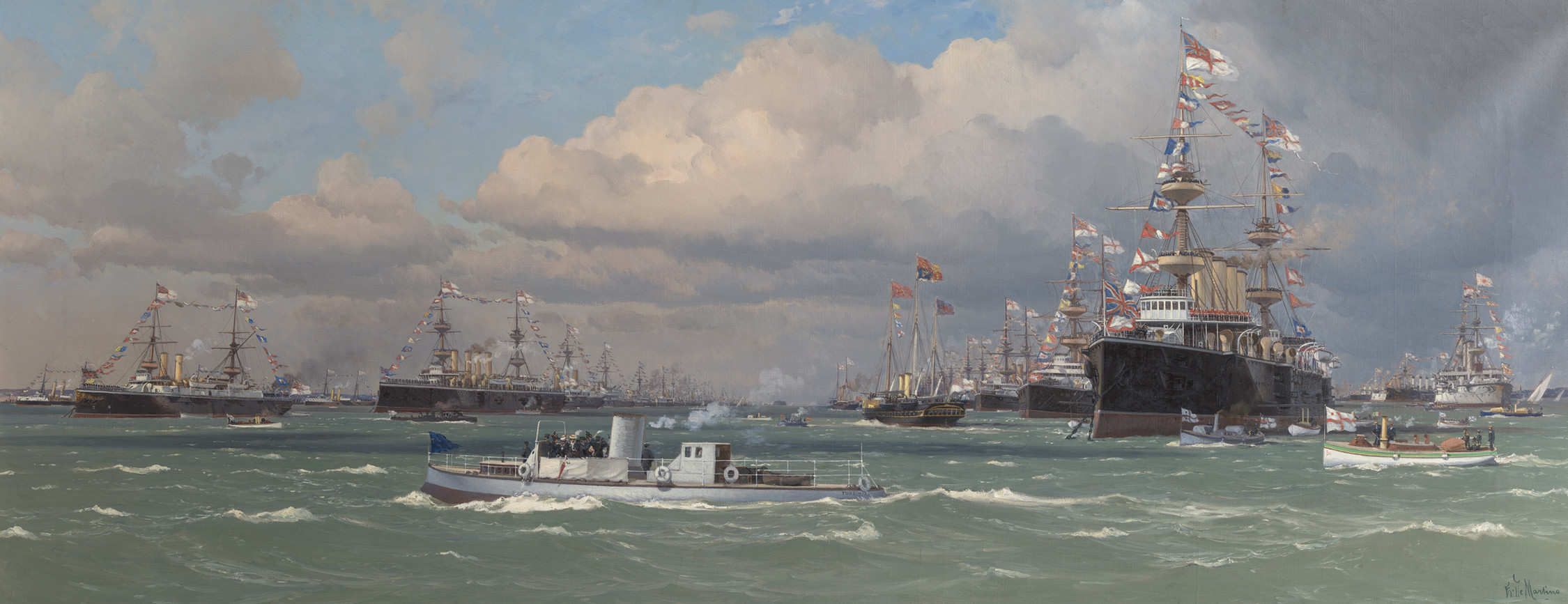
Famous rendition of the chase scene at Spithead by Chevalier de Martino, the Queen’s painter, now at Buckingham.
After his meticulous preparations, Parsons’s turbinia closed abreast of the four line formations of 165 warships, each five miles in length. At the time that was the largest fleet ever assembled. QueenVictoria, no longer in her prime at the time declined the invitation, and she was represented by the Prince of Wales (later King Edward VII) inspecting for his yacht HMY Victoria and Albert, up and down the lines to salute impecably aligned and dress sailors and officers, while the ship were sporting their full regalia, all pennants out flapping in the wind as a multicolor clapping crowd. He eventually anchored off HMS Renown to received admiralty’s top brass and foreign admirals for a reception.
Suddenly, while everyone was on deck, a lookout signalled a “hot pursuit”, there, passing in front of the line, a small white steam launch was racing out, chased by an armed steam cutter eager to reconduct by gunpoint whatever brat that just entered the perimeter. Knowing well where was positioned HMS Renown, Parsons went on racing towards the ship, raising further eyebrows and causing the security staff this day having a sweat. She easily evaded the navy picket boat in chase, almost swamping it with her wake. Apart firing their rifles, to intimate the Turbinia to stop, there was nothing they could do.
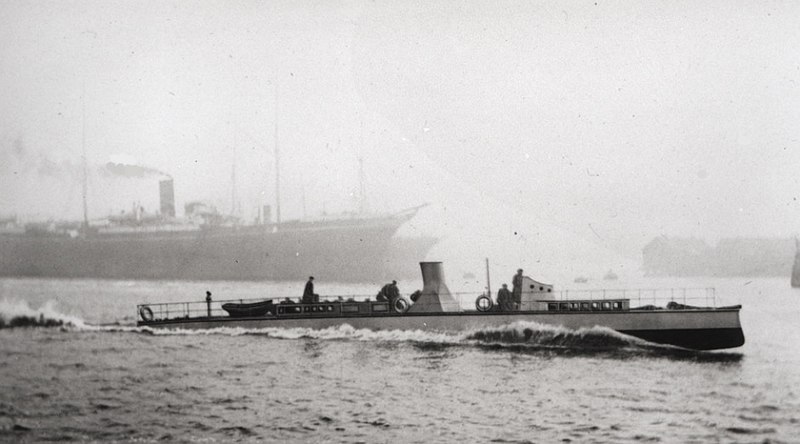
Turbinia arranged to be in sight of Renown, then made a full turn and raced down the line between ships and back at full speed, recorded at 34 knots. Fortunately for him, the sea was not too choppy, and between the massive battleship’s hulls water was just lake-like, enabling the vessel to reach its greater speed unempeded. Some in the admiralty saw it as a prank, and the ship hamless, having no obvious weapons on sight, but few realized it was a demonstration of a new and revolutionary marine propulsion. When Parsons started to run out of coal, he veered off the perimeter and again, evaded a cutter in intercept, then ultimately came to rest at the berth he started from a hour ealier. Remarked, he was reported in all the country’s news as the unexpected “accident” or “prank” of the review. But the admiralty soon enquired about, to find a proactive Parsons that came forward to revendicate the whole affair. Some wanted to have him fined for the “disturbance and reckless navigation”, but other recoignised immediately the feat as what it was.
Consequences
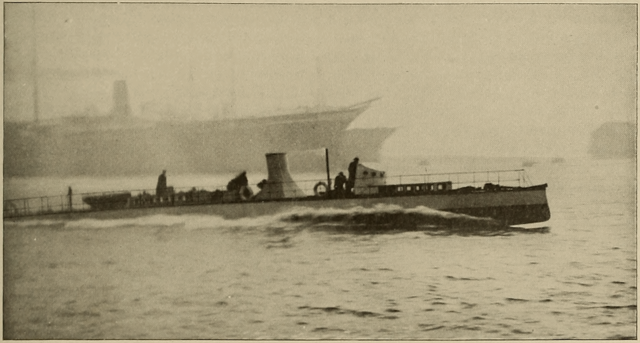
The Prince of Wales also reported the incident to the Queen and in due time they were informed by the admiralty about it. Impressed, the Queen then ordered Chevalier Eduardo de Martino (Marine Painter to the Queen) in a Court Circular for Balmoral on 10 June 1898 to showcase his painting of the even, retaken for engravings made in newspapers to relate the event, with the Jubilee Naval Review (which he was painting anyway) of the event, for the Queen to inspect. His painting was first hung at Osborne and in 1907, ended at Buckingham Palace.
There were other recordings of the event: Photographer and cinematographer Alfred J. West took several photographs of Turbinia at full speed at the review (here). Later Sir Charles Parsons (annoited indeed by the queen in between) filmed and shot Turbinia making a run on the River Tyne up to the North Sea. These photos would become the very embodiment of naval speed for decades.
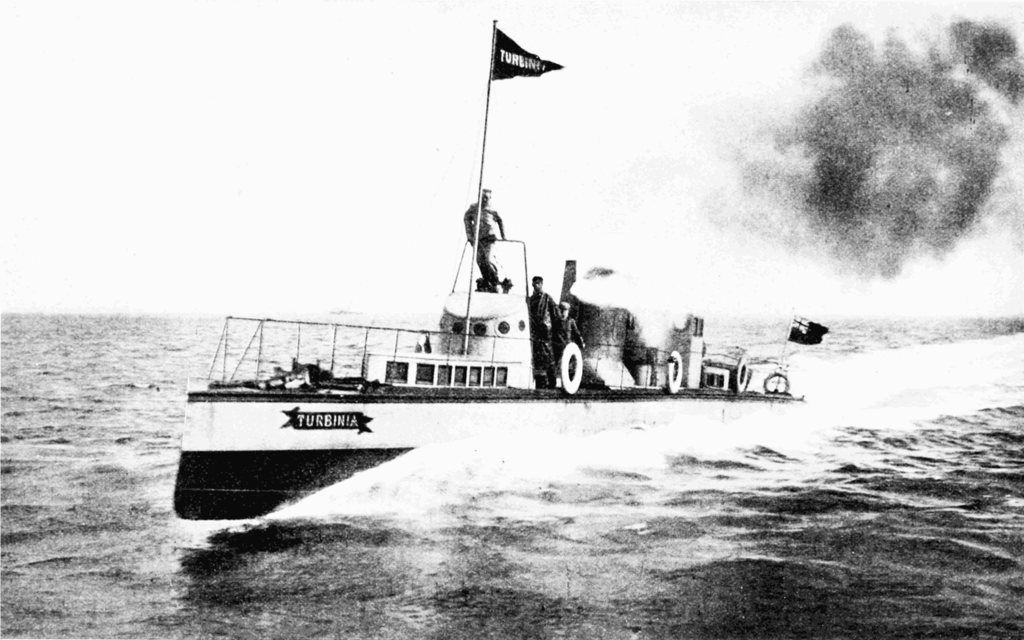
There were further high speed trials this time attended by the Admiralty, and Parsons completed to set up the “Turbinia Works” at Wallsend to propose an adapattion of the design for the Navy. This was secured by a contract to build engines for two new prototype destroyers, HMS Viper and Cobra (launched 1899, see later). In 1901 they were pushed so hard on trials both were lost to accidents but the Admiralty now believed in the concept.
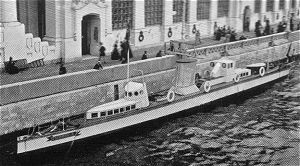 In between, by 1900, Turbinia steamed to Paris to try to sell his concept to the top navy brass of the Marine Nationale, which were also impressed by its run on the Seine, before being displayed at the Paris Exhibition. The French looked at the turbine like a potentially desirable option for its own destroyers, albeit later it decided against, with French DDs built in 1899-1908 keeping triple expansion engines. Parson would sell the idea also for trade vessels, with the first first turbine-powered merchant TS King Edward built the next year in 1901. The Admiralty in 1905 took the bold step of clearing that from 1905 all his destroyers would be turbine-powered. The same year, and despite initial reisistance or such type of ship as it was deemed unfeasible, Fisher obtained his pet project, HMS Dreadnought, would be the first turbine-powered battleship. She was launched a year after and combined a speed superior to many cruisers of the time, with the largest arillery ever seen.
In between, by 1900, Turbinia steamed to Paris to try to sell his concept to the top navy brass of the Marine Nationale, which were also impressed by its run on the Seine, before being displayed at the Paris Exhibition. The French looked at the turbine like a potentially desirable option for its own destroyers, albeit later it decided against, with French DDs built in 1899-1908 keeping triple expansion engines. Parson would sell the idea also for trade vessels, with the first first turbine-powered merchant TS King Edward built the next year in 1901. The Admiralty in 1905 took the bold step of clearing that from 1905 all his destroyers would be turbine-powered. The same year, and despite initial reisistance or such type of ship as it was deemed unfeasible, Fisher obtained his pet project, HMS Dreadnought, would be the first turbine-powered battleship. She was launched a year after and combined a speed superior to many cruisers of the time, with the largest arillery ever seen.
Crosby incident
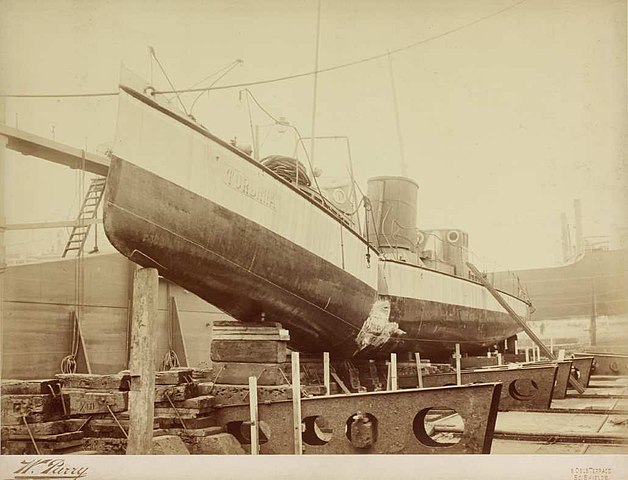
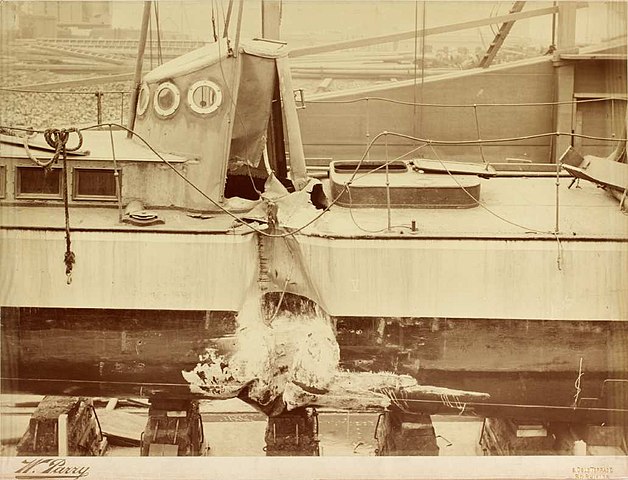
On 11 January 1907, Turbinia was hit by the barge Crosby, just launched across the river, from the south bank. She was berthed on other side of the Tyne, and keeping momentum, nothing could stop the barge to puncture the lighweight hull, almost breaking Turbinia in half. She was took off the water, repaired and later made a publicity stunt for photos, steaming alongside RMS Mauretania, first turbine-powered liner after her launch and later would come back as the ship was completed for photos showing as much she was dwarved. However on the launch day of the giant liner, so far the largest ship afloat, she experience mechanical problems and had to cease accompanying Mauretania down the River Tyne, up to the sea.
Fate
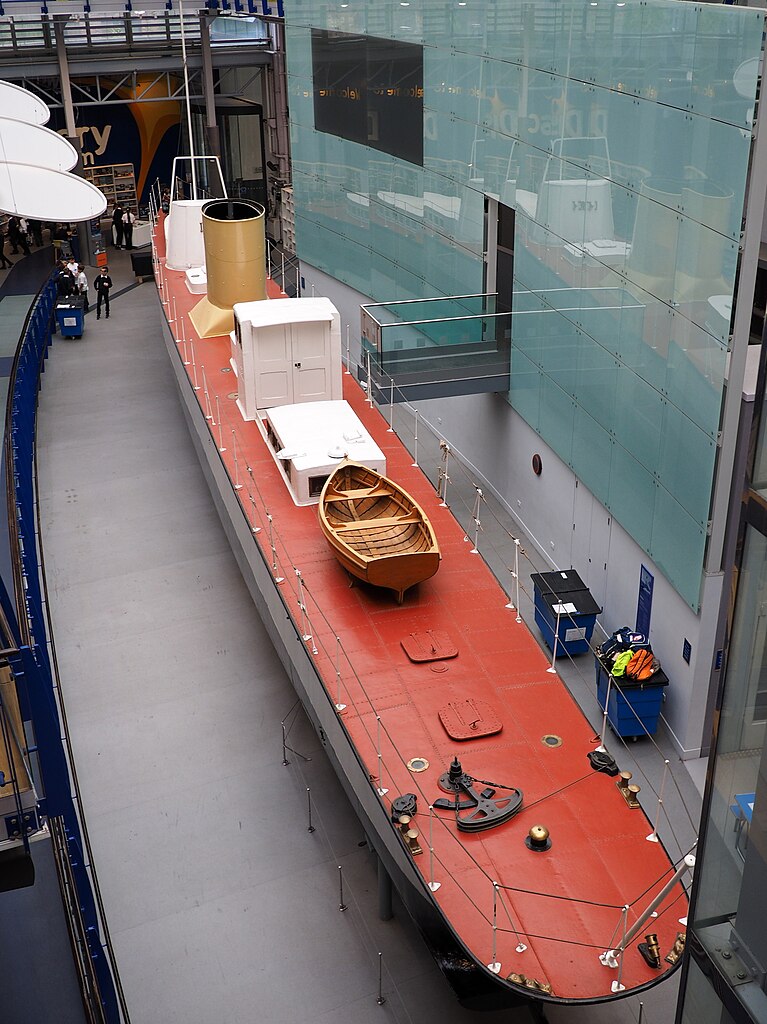
After a few more runs for the show and tests, Turbinia was struck, having no longer use. The Parsons company did not wanted so see her rotting berthed and instead to avoid deterioration she was lifted out of the water in 1908 and preserved in a wooden hangar, still displayed for curious onlookers many years afterwards. 1926, the directors of Parsons offered her to the Science Museum in London. She could not be carried as such and was cut in half to be hauled in two voyages on the lagrest steam tractor available. The rear came out complete with engines and propellers and this section ended at the South Kensington museum in London, lacking spece to show it all. The fore section was stored and by 1944 she was carried for display at the Newcastle Corporation and city’s Exhibition Park. In 1959, the Science Museum had the aft section retired from the exhibition for storage and possible restoration. By 1961, this was reunited with the forward section, to be displayed at the Newcastle Municipal Museum of Science and Industry with a full reconstruction started in 1983 initially for the centennary in 1997.
On 30 October 1994 her launch centennary was celebrated, and she was moved to Newcastle’s Museum of Science and Engineering (later “the Discovery Museum”) displayed on the great hall by March 1996. She was later listed as part of the National Historic Fleet. In 2000 she was refurbished and ended in a new gallery. The later had its roof raised by one storey so that two levels viewing galleries could be installed. She is still the star of the show.
Read More/Src
Books
Brown, Les (2023). Royal Navy Torpedo Vessels. Barnsley, UK: Seaforth Publishing
Links
g.eng.cam.ac.uk/
100objectsne.co.uk
rmg.co.uk/collections/objects/rmgc-object-67214
collection.sciencemuseumgroup.org.uk/
web.archive.org/ History Landmarks
ortwmuseums.org.uk
nationalhistoricships.org.uk/
tynebuiltships.co.uk/
web.archive.org sci_charles_parsons.php
web.archive.org/ imarest.org.uk
wiki Turbinia
en.wikipedia.org Charles_Algernon_Parsons
collection.sciencemuseumgroup.org.uk



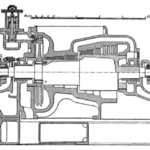
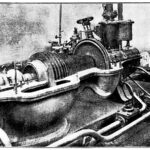
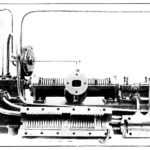
 Latest Facebook Entry -
Latest Facebook Entry -  X(Tweeter) Naval Encyclopedia's deck archive
X(Tweeter) Naval Encyclopedia's deck archive Instagram (@navalencyc)
Instagram (@navalencyc)





 French Navy
French Navy Royal Navy
Royal Navy Russian Navy
Russian Navy Armada Espanola
Armada Espanola Austrian Navy
Austrian Navy K.u.K. Kriegsmarine
K.u.K. Kriegsmarine Dansk Marine
Dansk Marine Nautiko Hellenon
Nautiko Hellenon Koninklije Marine 1870
Koninklije Marine 1870 Marinha do Brasil
Marinha do Brasil Osmanlı Donanması
Osmanlı Donanması Marina Do Peru
Marina Do Peru Marinha do Portugal
Marinha do Portugal Regia Marina 1870
Regia Marina 1870 Nihhon Kaigun 1870
Nihhon Kaigun 1870 Preußische Marine 1870
Preußische Marine 1870 Russkiy Flot 1870
Russkiy Flot 1870 Svenska marinen
Svenska marinen Søværnet
Søværnet Union Navy
Union Navy Confederate Navy
Confederate Navy Armada de Argentina
Armada de Argentina Imperial Chinese Navy
Imperial Chinese Navy Marinha do Portugal
Marinha do Portugal Mexico
Mexico Kaiserliche Marine
Kaiserliche Marine 1898 US Navy
1898 US Navy Sovietskiy Flot
Sovietskiy Flot Royal Canadian Navy
Royal Canadian Navy Royal Australian Navy
Royal Australian Navy RNZN Fleet
RNZN Fleet Chinese Navy 1937
Chinese Navy 1937 Kriegsmarine
Kriegsmarine Chilean Navy
Chilean Navy Danish Navy
Danish Navy Finnish Navy
Finnish Navy Hellenic Navy
Hellenic Navy Polish Navy
Polish Navy Romanian Navy
Romanian Navy Turkish Navy
Turkish Navy Royal Yugoslav Navy
Royal Yugoslav Navy Royal Thai Navy
Royal Thai Navy Minor Navies
Minor Navies Albania
Albania Austria
Austria Belgium
Belgium Columbia
Columbia Costa Rica
Costa Rica Cuba
Cuba Czechoslovakia
Czechoslovakia Dominican Republic
Dominican Republic Haiti
Haiti Hungary
Hungary Honduras
Honduras Estonia
Estonia Iceland
Iceland Eire
Eire Equador
Equador Iran
Iran Iraq
Iraq Latvia
Latvia Liberia
Liberia Lithuania
Lithuania Mandchukuo
Mandchukuo Morocco
Morocco Nicaragua
Nicaragua Persia
Persia San Salvador
San Salvador Sarawak
Sarawak Uruguay
Uruguay Venezuela
Venezuela Zanzibar
Zanzibar Warsaw Pact Navies
Warsaw Pact Navies Bulgaria
Bulgaria Hungary
Hungary

 Bundesmarine
Bundesmarine Dutch Navy
Dutch Navy Hellenic Navy
Hellenic Navy Marina Militare
Marina Militare Yugoslav Navy
Yugoslav Navy Chinese Navy
Chinese Navy Indian Navy
Indian Navy Indonesian Navy
Indonesian Navy JMSDF
JMSDF North Korean Navy
North Korean Navy Pakistani Navy
Pakistani Navy Philippines Navy
Philippines Navy ROKN
ROKN Rep. of Singapore Navy
Rep. of Singapore Navy Taiwanese Navy
Taiwanese Navy IDF Navy
IDF Navy Saudi Navy
Saudi Navy Royal New Zealand Navy
Royal New Zealand Navy Egyptian Navy
Egyptian Navy South African Navy
South African Navy






























 Ukrainian Navy
Ukrainian Navy dbodesign
dbodesign